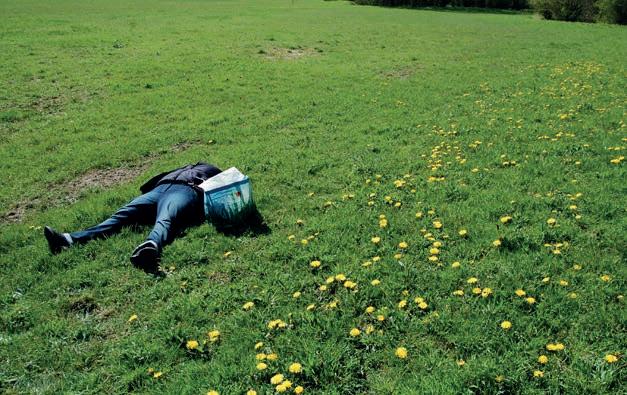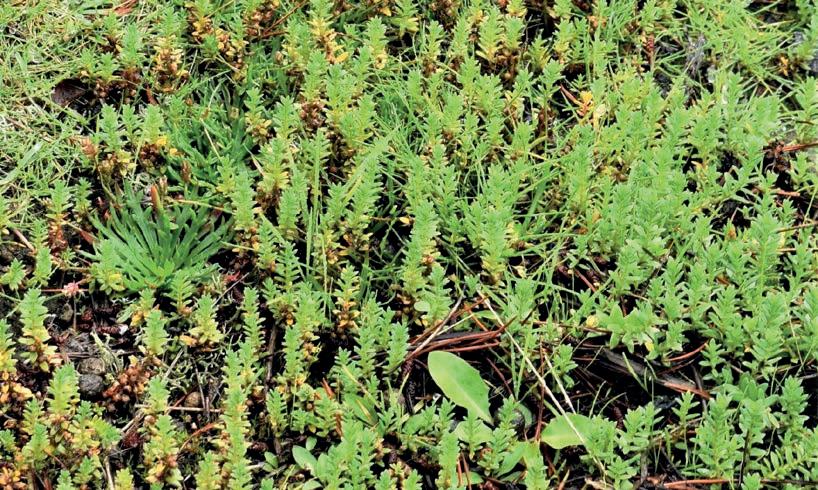
3 minute read
Glaux maritima (Sea Milkwort) dominant on a six-halophyte road verge in South Northumberland John Richards
Rich, T.C.G. 2010. The dandelions of Cardiff. https://museum.wales/ curatorial/biosyb/vascular/collections/ taraxacum/cardiff. Rich, T.C.G., McDonnell, E. J. &
Lledó, M. D. 2008. Conservation of Britain’s biodiversity: the case of
Advertisement
Hieracium cyathis and its relationship to other apomictic taxa. Botanical Journal of the Linnean Society 156: 669–680. Rich, T.C.G., Houston, L., Robertson, A. & Proctor, M. C. F. 2010. Whitebeams,
Rowans and Service Trees of Britain and
Ireland. A monograph of British and Irish
Sorbus L. BSBI Handbook no 14.
Botanical Society of the British Isles,
London. Richards, A.J. 1972. The Taraxacum
Flora of the British Isles. Watsonia 9 (supplement): 1–141. Richards, A.J. 2021. Field handbook to ‘That’s half of North Meadow collected…’ Tim Rich
British and Irish dandelions. BSBI
Handbook no 23. Botanical Society of Britain and
Ireland, Durham. Sell, P.D. & Murrell, J.G. 2006. Hieracium L., in Flora of Great
Britain and Ireland. 4: 218–421. Cambridge University
Press, Cambridge. Simpson, N.D. 1960. Bibliographical index of the British flora.
Privately published. Digital version available at archive. bsbi.org/SimpsonsIndex.pdf Sudre, H. 1902. Les Hieracium du centre de la France d’après les types de Jordan et de Boreau. Revue Historique, Scientifique & Littéraire du Département du Tarn (ancien pays d’Albigeois) 19: 77–124 and 211–258. Nouguiés, Albi. Van Oostrum, H., Sterk, A.A. & Wijsman, H.J.W. 1985. Genetic variation in agamospermous microspecies of Taraxacum sect. Erythrosperma and sect. Obliqua. Heredity 55: 223–228.
Tim G.C. Rich tim_rich@sky.com
Glaux maritima (Sea Milkwort) dominant on a sixhalophyte road verge in South Northumberland
JOHN RICHARDS
Glaux maritima (Sea Milkwort), common and widespread in maritime locations, has been recorded in very few inland locations on salted road verges. As far as I can ascertain from the BSBI maps website (database.bsbi.org/maps), it has only been recorded in nine hectads away from tidal influence: six in the West Midlands, one in eastern Scotland (NO17), one on Hartside Summit in Cumbria (NY64) and two in South Northumberland. The record for NY47 should be for SD47 which is coastal. One of the Northumberland records I made myself while listing plants in NY9853 (Winnowshill, v.c.67) on 26 July, 2010. My recollection is that only a few isolated plants were present.
In August 2021 Jim Bowyer reported large quantities of Glaux maritima growing in what is presumably the same site, at NY 9825 5378, in company with Plantago coronopus (Buck’s-horn Plantain) first recorded from here in 2003, but which I failed to record in 2010. I visited this location on 30 August 2021. Glaux and P. coronopus both now occur in great quantities over some 700m distance on both
sides of the road between Winnowshill junction and Actonmill Bridge (from 250–300 m asl), and in many places both species are dominant, forming continuous carpets. Four other maritime species are also present as roadside halophytes: the now common-place Spergulariamarina (Lesser Sea-spurrey) (abundant), Puccinellia distans (Reflexed Saltmarshgrass) (scattered), Plantago maritima (Sea Plantain) (two clumps) and Sagina maritima (Sea Pearlwort). I had searched carefully for the Pearlwort, which is found in a few of our best upland halophyte communities, but without success, but a careful later examination of a photo of one of the Sea Plantains revealed several small plants of the Pearlwort. Although I have found five halophyte species together on upland verges in S. Northumberland on several occasions, this is the first time I have found six species cooccurring.
The halophyte communities on road verges below Winnowshill junction contain an eclectic range of other species, with locally abundant Acaena novaezelandiae (Pirri-pirri-bur), considerable quantities of Anagallis arvensis (Scarlet Pimpernel), a rather uncommon plant with us, Gnaphalium uliginosum (Marsh Cudweed) and several patches of Polygonum rurivagum (Cornfield Knotgrass), which is proving to be a frequent co-habitant of upland roadside halophyte communities in our area. There are also considerable patches of the lichen Cladonia portentosa with which the Glaux intergrows.
One notable feature of these verges are piles of coarse gravel which are left for spreading on the gradient during icy conditions. These have been colonised by several of the halophyte species and Acaena novae-zelandiae. They are presumably mixed with salt, and it is tempting to suggest that they are the source of the seed of the less common halophytes.
Acknowledgement
My thanks to Jim Bowyer for communicating his records.
John Richards
High Trees, South Park, Hexham NE46 1BT
hightreesgarden@btinternet.com

Patch of Glaux maritima (Sea Milkwort) with a few plants of Plantago coronopus (Buck’s-horn Plantain) on the road verge at Winnowshill junction, S. Northumberland (v.c. 67), 30 August 2021. John Richards










